Vegetable Paella – A Veggie Twist On A Spanish Classic!
If you love paella, but you want to try a vegetarian version, you should definitely make vegetable paella, or paella de verduras.
Also known as arroz de verduras, this vegetarian and vegan dish is super filling and packed with flavor and color.
Don’t be fooled by the fact that it is made only with veggies!

There are many versions of this dish all all over Spain.
Since I’m from Alicante, the southern province in the Comunidad Valenciana, this recipe follows the ones I’ve learned from my grandma Ángeles, and my father-in-law Paco. They have been made and devoured in countless Sunday lunches.
Depending on where you are in Spain, this dish can be called paella de verduras or arroz de verduras (vegetable rice). It’s a dish usually eaten at lunchtime, especially on weekends, because it’s very filling and takes some time to prepare.
In restaurants or casa de comidas (take-away places), you may find this dish any day of the week. But for family and friends, it is mainly a weekend dish.
It’s also a dish that invites you to stay at the table for a long time, enjoying coffee, desserts, and conversation after the meal. This is what we call sobremesa in Spanish.
And please, don’t eat it with a cup of coffee on the side (I’ve seen it many times). You can enjoy it with a drink of your choice, like a beer, a glass of white wine, or just water.
Ingredients
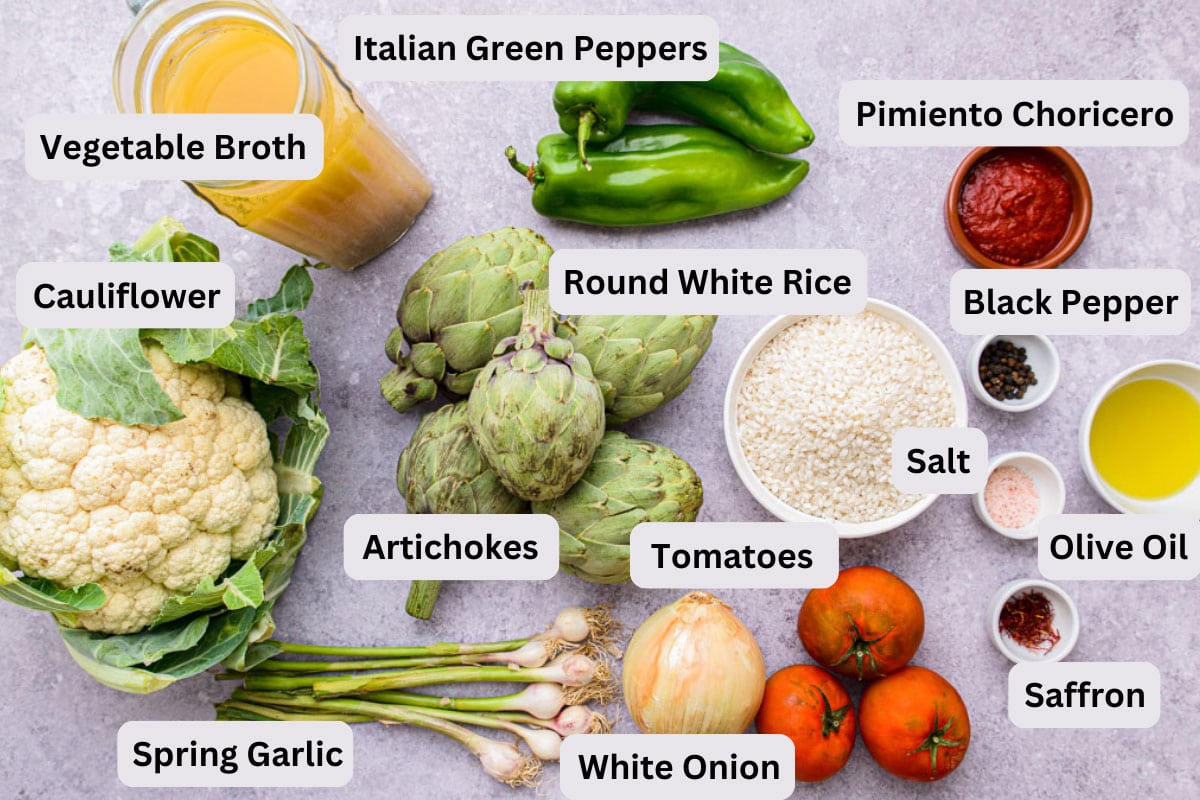
To make this recipe, here are the vegetable paella ingredients you will need. It definitely doesn’t go light on the vegetables!
- Artichokes – Choose artichokes with a green color that feel heavy and firm.
- Green Italian pepper – Also known as cubanelle pepper. Alternatively, you can use a small green bell pepper.
- Spring garlic – Sometimes also called green garlic or baby garlic.
- Cauliflower – You’ll need 1/2 head of a medium to large cauliflower. Or you can use a whole small head of cauliflower.
- Garlic clove – To add extra flavor.
- Onion – One white or yellow onion.
- Tomatoes – Large, juicy tomatoes.
- Olive oil – Doesn’t have to be extra virgin olive oil, but don’t use any other type of oil.
- Round white rice – Use short-grain rice, especially Bomba, Sendra, or Calasparra varieties. If you can’t find any of these, just choose one that is: white, short, and round. Risotto rice also works.
- Vegetable broth – Preferably homemade, but store-bought also works.
- Pimiento Choricero meat – Alternatively, you can use sweet paprika powder or ñora peppers.
- Salt – To enhance the overall flavor.
- Black pepper – To add a hint of spice.
- Saffron threads – Alternatively, you can use saffron powder.
- Water – Hot water to soak the saffron.
- Lemon – Optional; for serving.
- Allioli – Optional; for serving. It’s the Spanish version of aioli.
Recipe Tips and Substitutions
Before you make this Spanish vegetable paella, have a good read through this section where we cover all the recipe tips, tricks, and need-to-knows.
This will better prepare you for the recipe and ensure you get the best results!
Vegetables
The selection of vegetables we’re using are traditional ones. Other classic options are green peas, flat green beans, red peppers, and asparagus.
In general, vegetable paella can be made with almost any veggie. I’ve eaten delicious vegetable paellas with eggplant, zucchini and carrots. Just be creative and use the vegetables you like.
The only thing to avoid is leafy vegetables like spinach or Swiss chard.
Rice
The rice is the most important ingredient in paella, and the type you choose can make a big difference in the final dish.
The best rice for paella is short-grain rice, especially the varieties Bomba, Sendra, or Calasparra. If you can’t find any of them, simply choose one that is white, short, and round.
Italian risotto varieties can also work well, especially the Carnaroli variety, but sushi rice is a big no-no because it makes the paella sticky.
Avoid using basmati or any long-grain rice, whole-grain rice, or parboiled rice.
Oil
Olive oil is essential for paella, but you don’t have to use extra virgin olive oil. Any other oil would alter the flavor too much, so avoid it.
Paprika or pimiento choricero
In the sofrito stage, we use either sweet paprika powder, ñora peppers, or choricero peppers. Any of them adds a delicious layer of umami and complexity to the paella.
Choricero peppers and ñora peppers are two different types of dried peppers that are a bit sweet and slightly bitter (they are not spicy at all).
If you can find either ñora or choricero peppers that’s great, but in case you can’t, use sweet paprika powder, which will give very similar results.
In Spain, it is also possible to find choricero pepper meat, so you don’t have to hydrate them and scrape their flesh.
If you can only find them dried, simply hydrate them with hot water while you are frying the veggies, and then scrape their meat with a knife and add it to the sofrito mixture in the mortar and pestle.
Saffron
Saffron adds color and a subtle flavor to the paella. If possible, use it in threads since it gives the best results – but it is a bit pricey. If you can only find it in powder form, that will also work.
Avoid using turmeric since it changes the flavor drastically.
By making a saffron tea instead of adding the threads directly, we ensure that the flavor and color are evenly distributed throughout the paella.
Vegetable Broth
Using vegetable broth instead of water will make the paella more flavorful.
You can make your own broth with artichoke scraps, leeks, carrots, onions, and a sprig of celery (prepare it the day before), or use store-bought broth if you are short on time.
To Cook
Stove and Heat
To make a good paella, you need a large stove that can heat the whole pan evenly. Otherwise, the paella may not cook evenly. In Spain, we use a special round gas stove that attaches to a gas bottle.
You also need to control the heat throughout the cooking process. Once you add the rice to the paella, start with high heat and then lower it to medium-low. Finally, let the paella rest off the heat or with the heat turned off.
Cooking the vegetables
Cooking the veggies separately allows them to reach the perfect cooking point.
Some vegetables, like peppers and spring garlic, can get overcooked easily, which is why we add them towards the end. Cauliflower does not need to be fried before being added to the paella.
Cooking the rice
It is crucial not to move the rice once it has been distributed in the pan. If you stir the rice, it will release starch and become mushy (think of Italian risotto).
You can also adjust the texture of the rice to your liking. If you want a drier and al dente rice, use the exact amount of liquid I suggested and do not cover the paella with a lid at the end.
If you want creamier rice (“caldoso”), add a little more broth (about 1/3 cup) and cover the paella with a lid for a few minutes after turning off the heat.
Personally, I like my rice to be creamy but not mushy – so the type of rice you choose is important.
How to Make Vegetable Paella – Step by Step Instructions
In this section, you can see exactly how we make this vegetarian paella recipe.
All the photos of the recipe process have been included so that you can track your progress at home and see exactly how we made ours.
Of course, you can also find the recipe card at the end of this post, with all the relevant details – like cooking times and ingredient amounts.
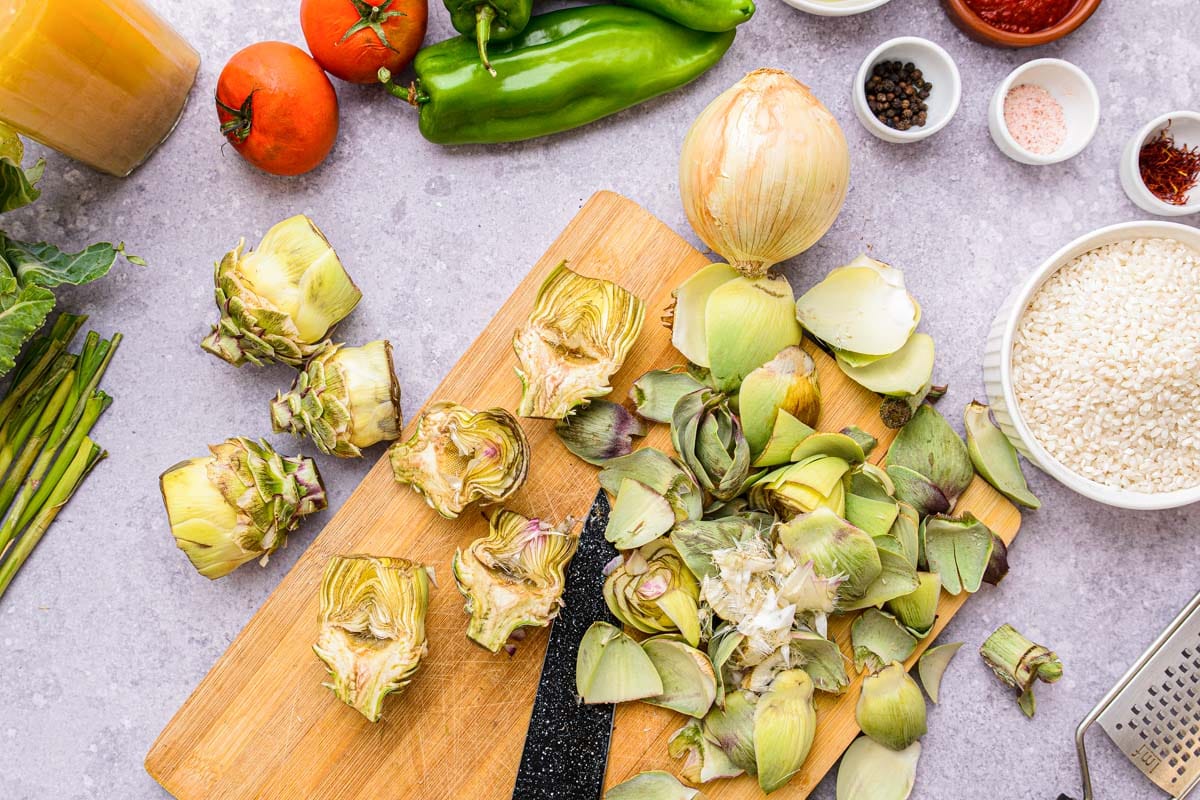
First, let’s prepare the vegetables. Wash and dry the vegetables as applicable (peppers, cauliflower, tomatoes).
Cut off the stems of the artichokes, peel off the outer leaves, and cut them in half.
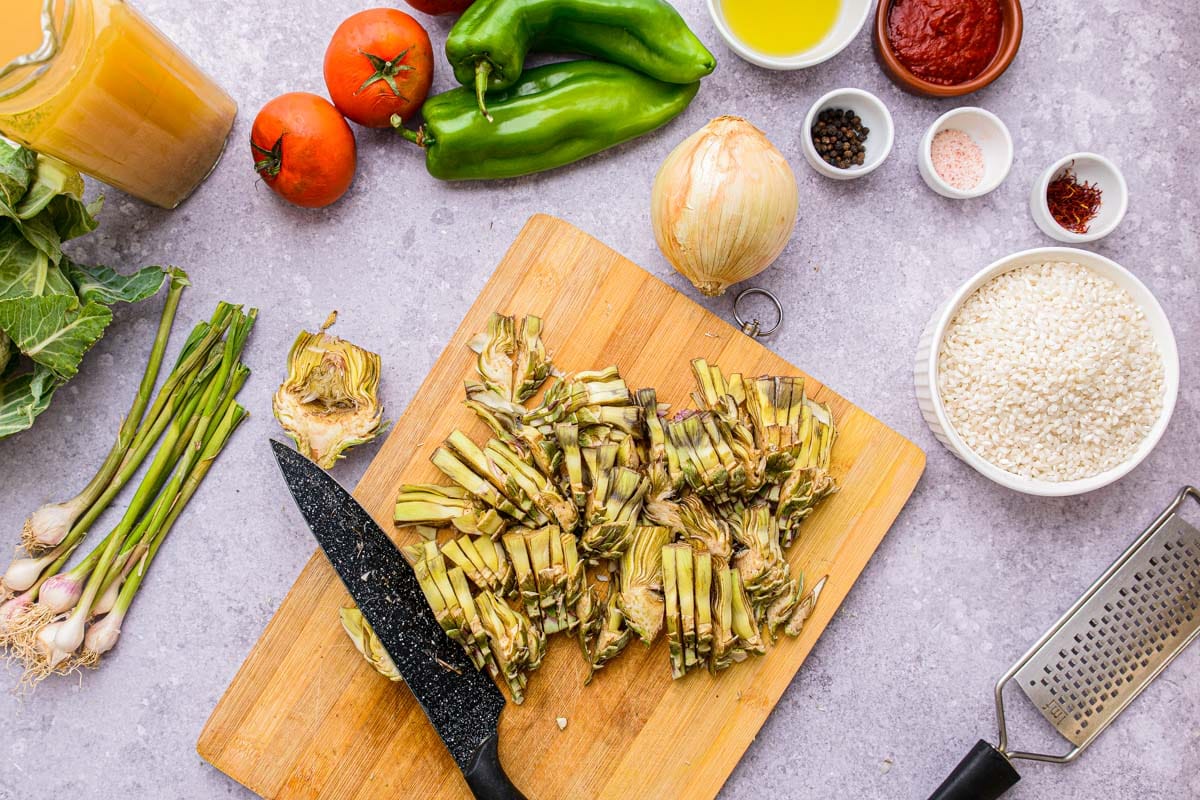
Then remove the inner hairs and cut the artichokes into thin slices.
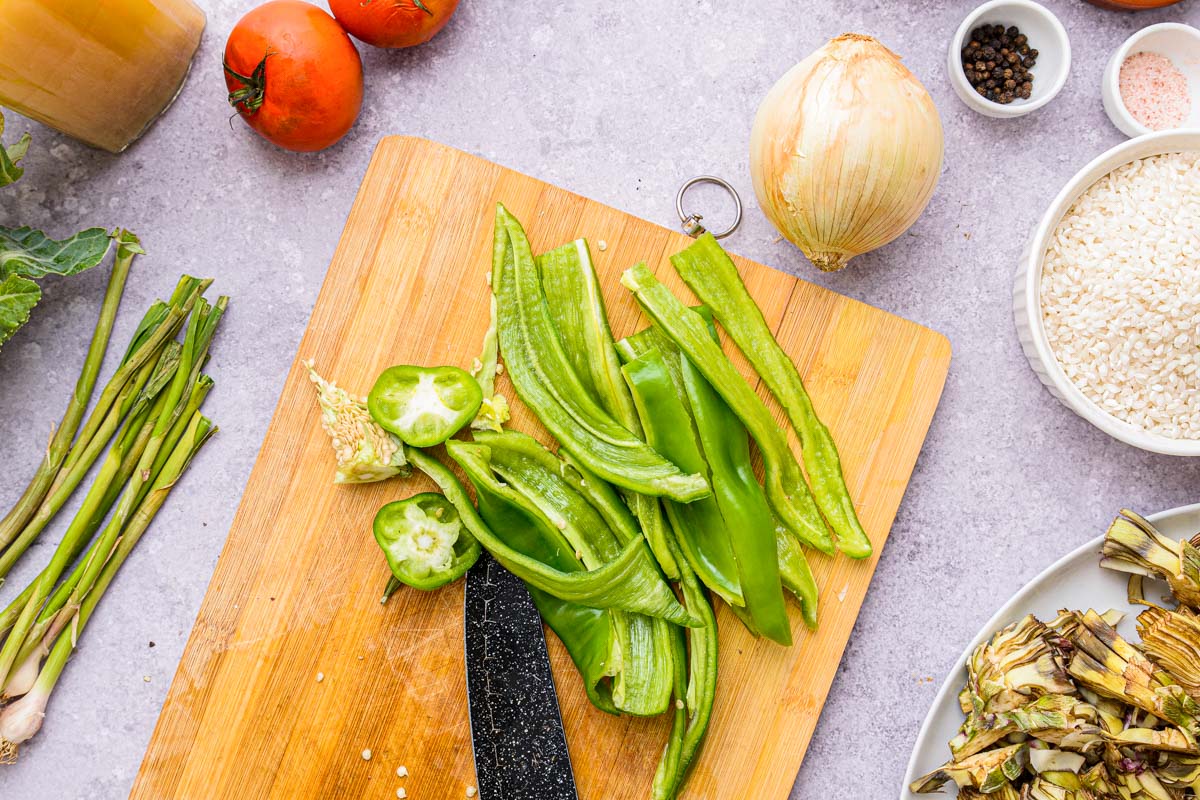
Cut off the top of the peppers and remove the seeds. Slice it into long strips.
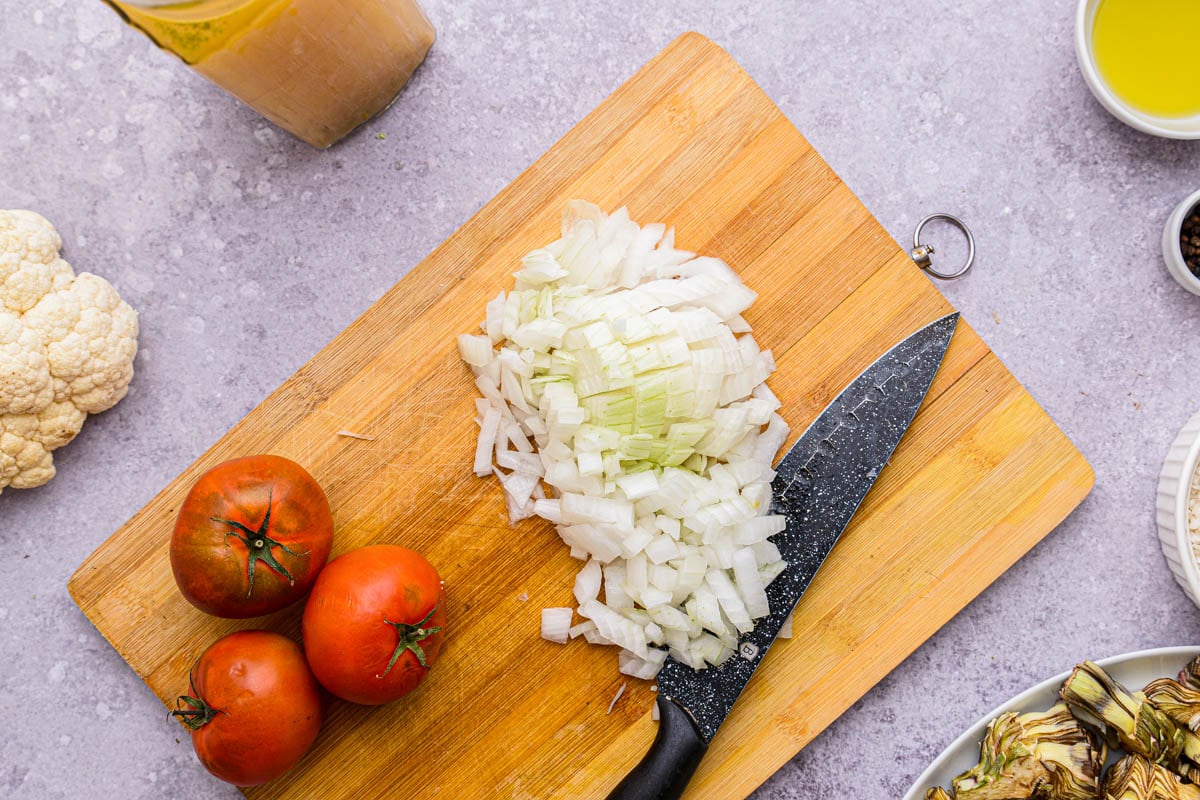
Peel the outer layer of the onion and dice it finely.
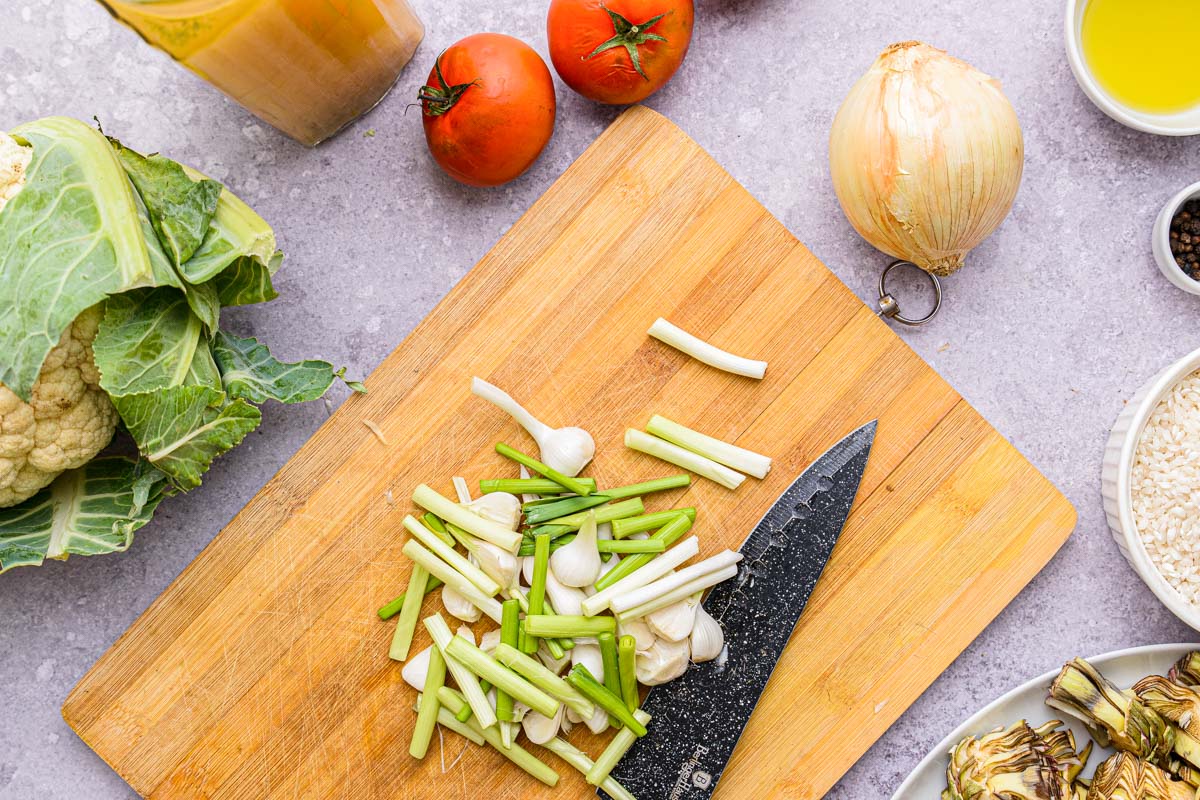
Cut off the roots and peel the outer layer of the spring garlic, also known as green garlic. Then cut it into chunks.
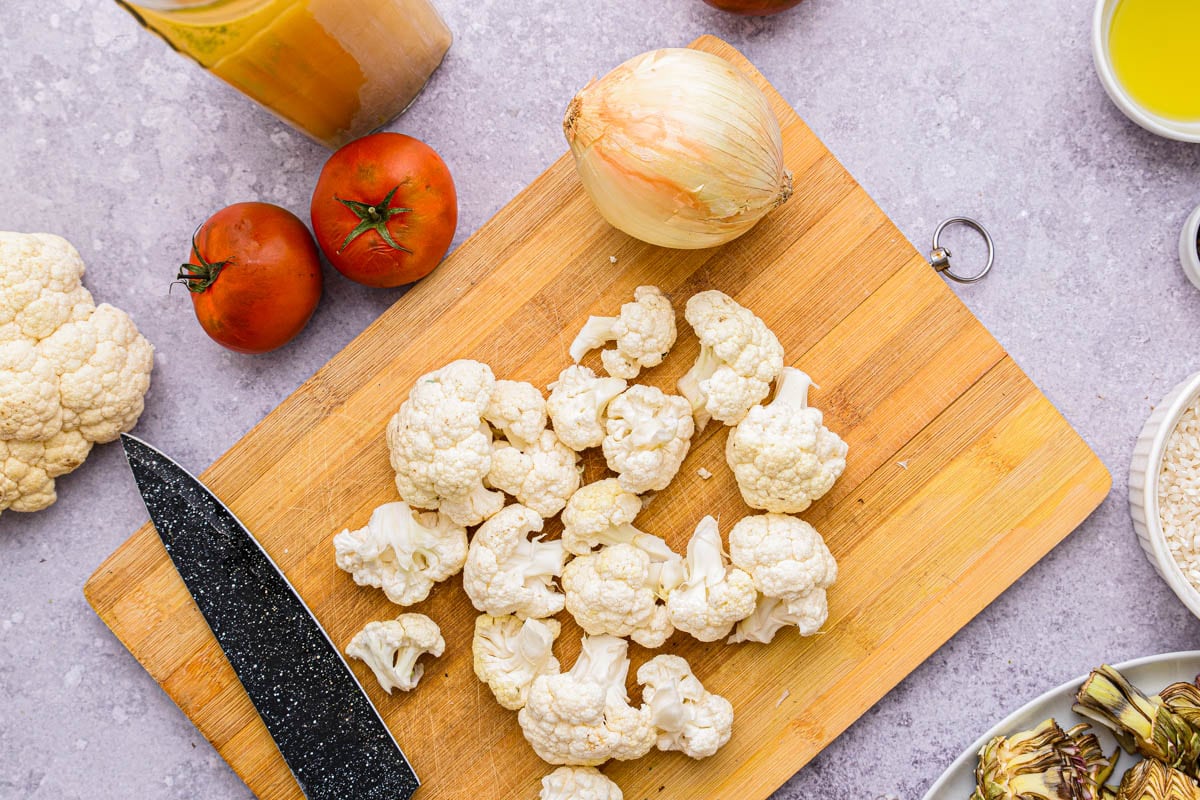
Cut off the stem of the cauliflower and break it into small florets.
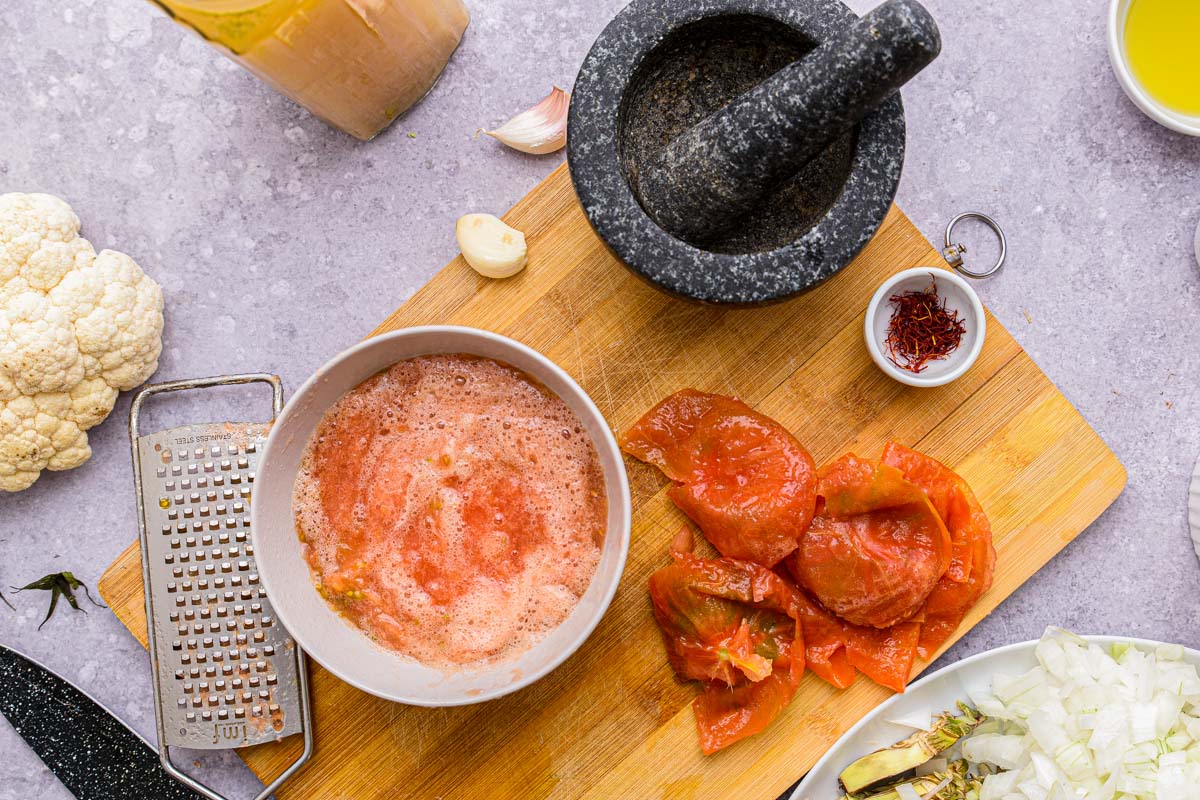
Peel the garlic clove and cut the tomatoes in half. Then grate the tomato pulp into a small bowl.
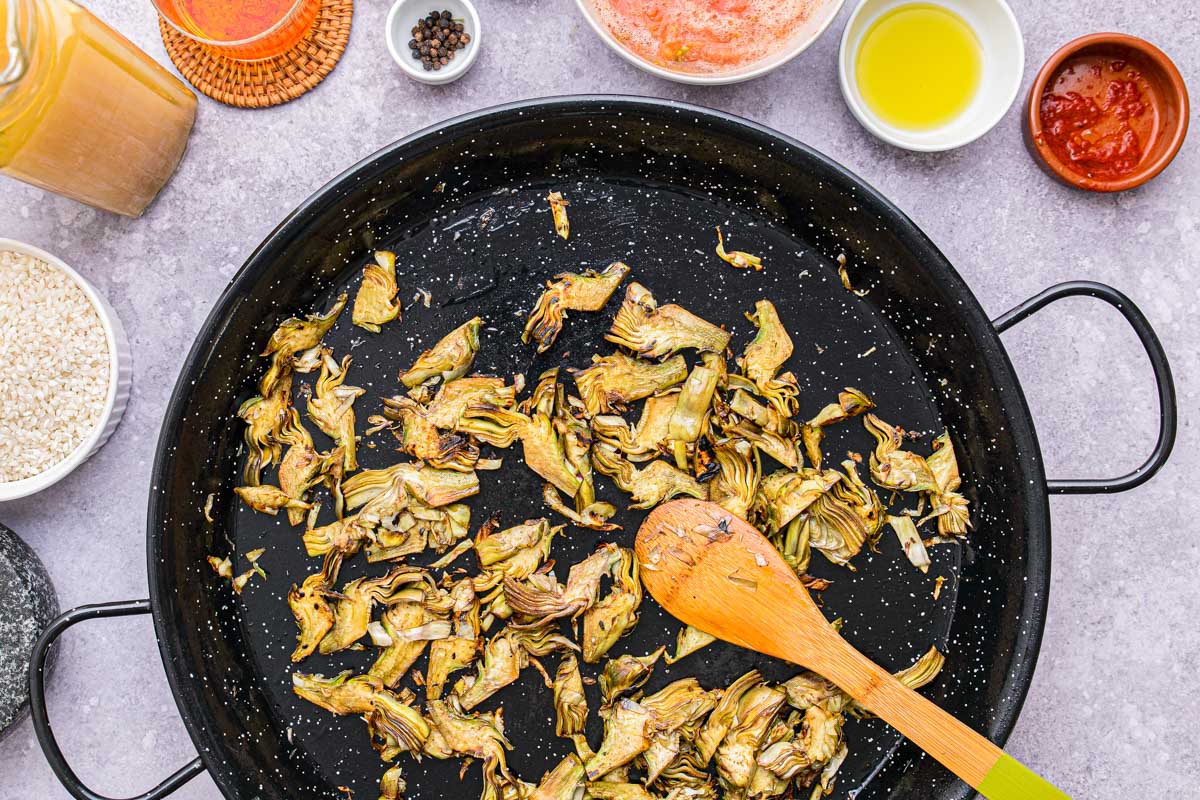
In a paella pan, heat up the olive oil and fry some of the vegetables one by one in batches.
First, add the artichokes to the pan and fry for a couple of minutes, then remove and set aside.
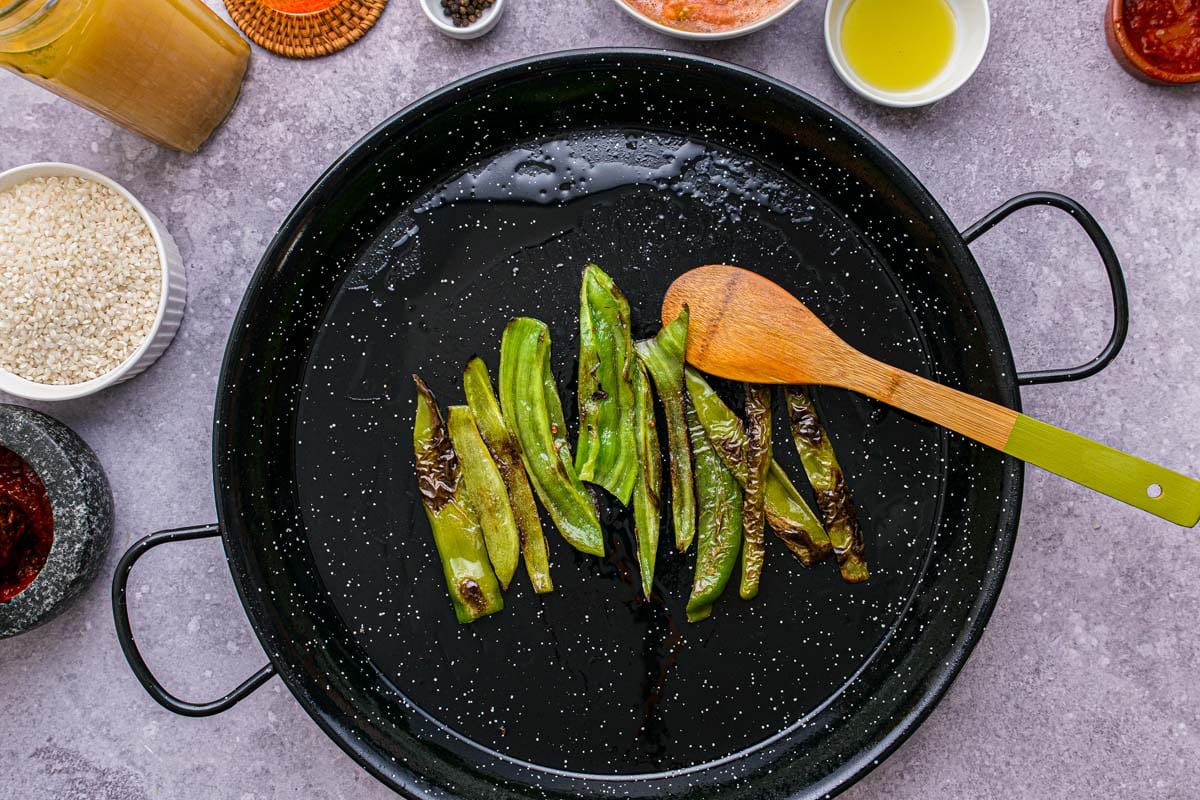
Add the green pepper and cook for 5 minutes, stirring regularly. Remove and set aside.
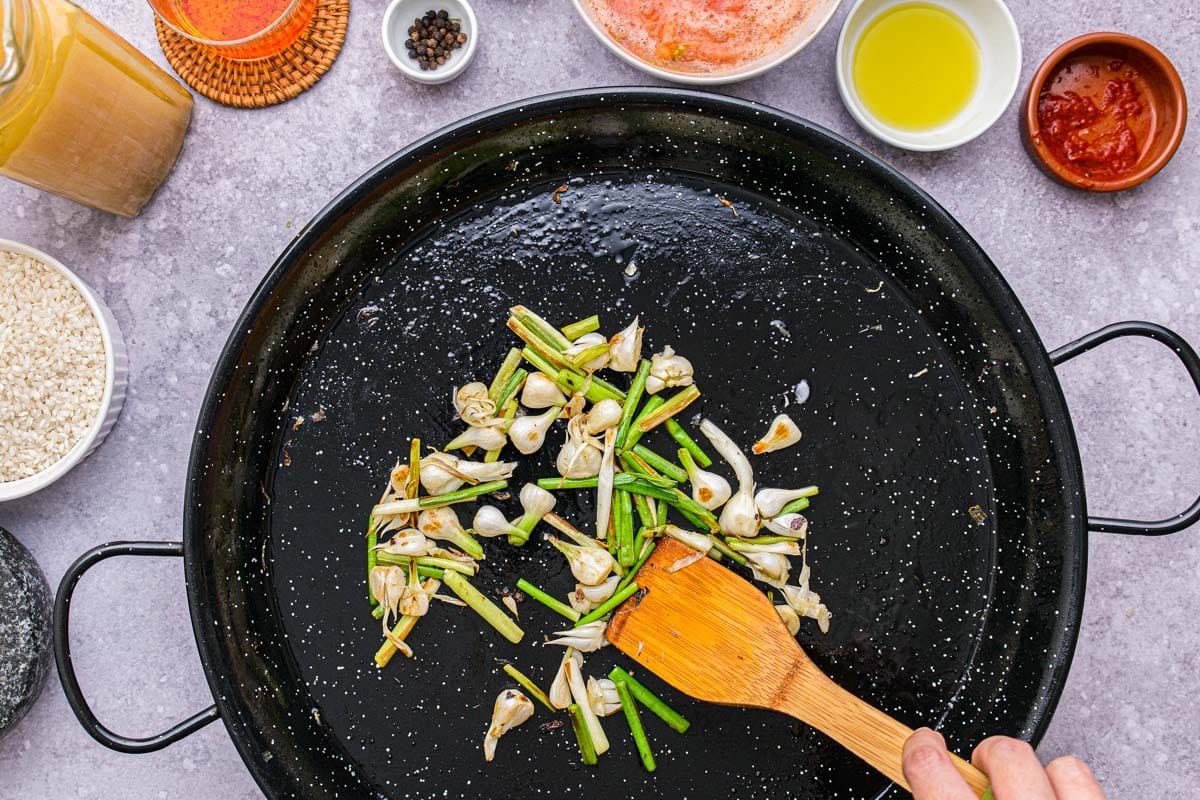
Add the spring garlic, cook for a couple of minutes, stirring regularly, then remove.
At this time, also add the saffron threads to a small bowl and pour hot water over them. Let them infuse while you continue cooking the rest of the ingredients.
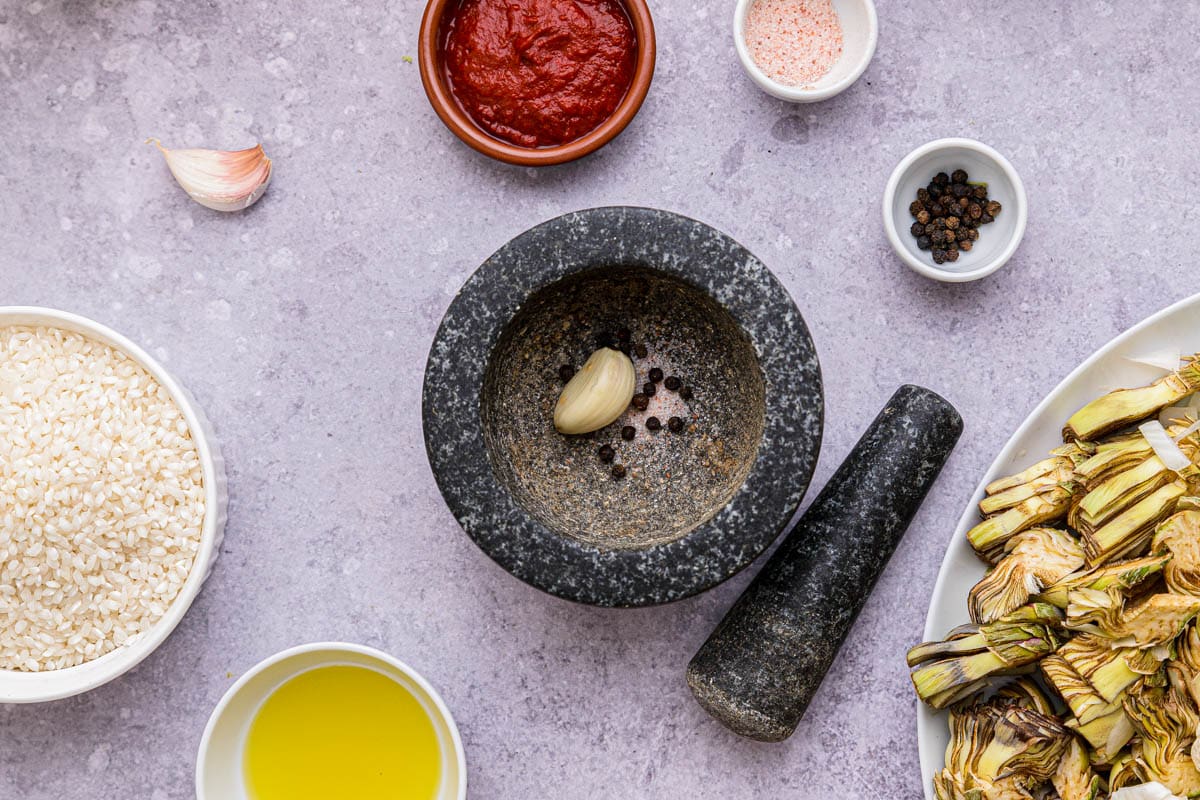
In the mortar and pestle, add the garlic clove, ½ teaspoon of salt, a dash of olive oil, and mash them until you have a fine paste.
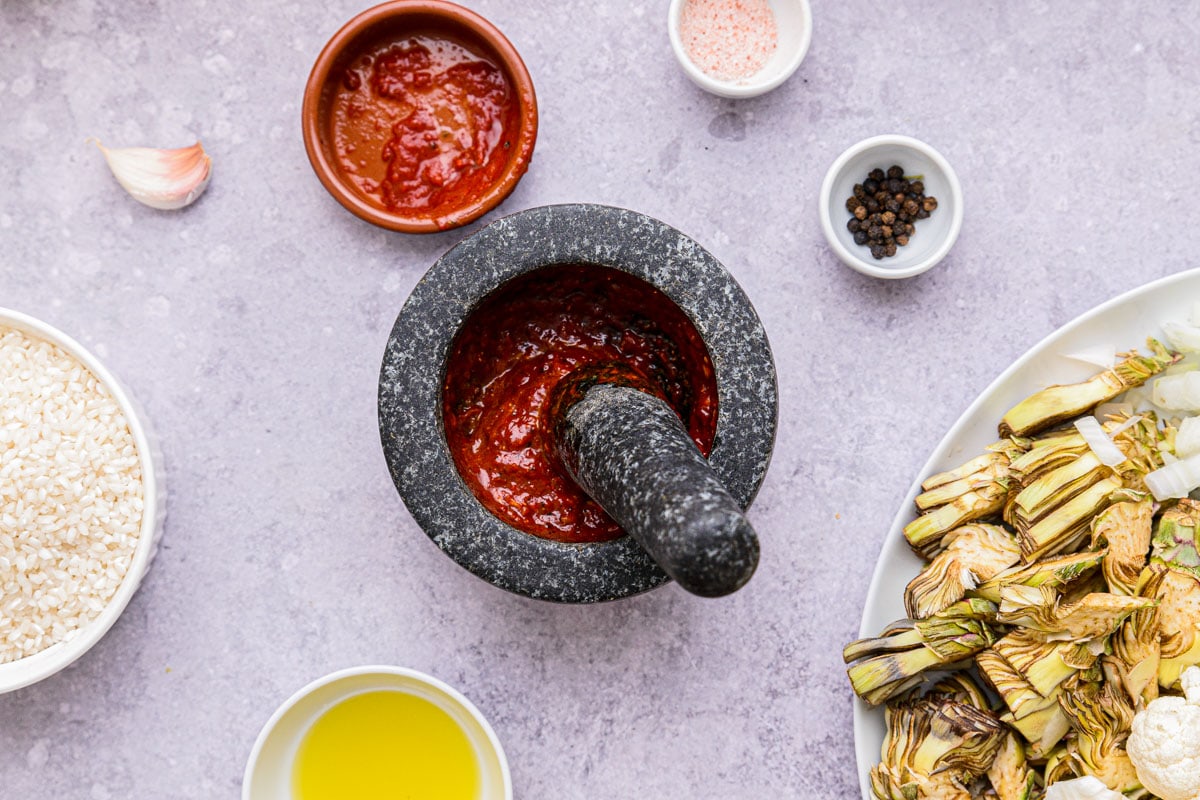
Add the choricero pepper meat or paprika powder, salt, and pepper, and mix well.
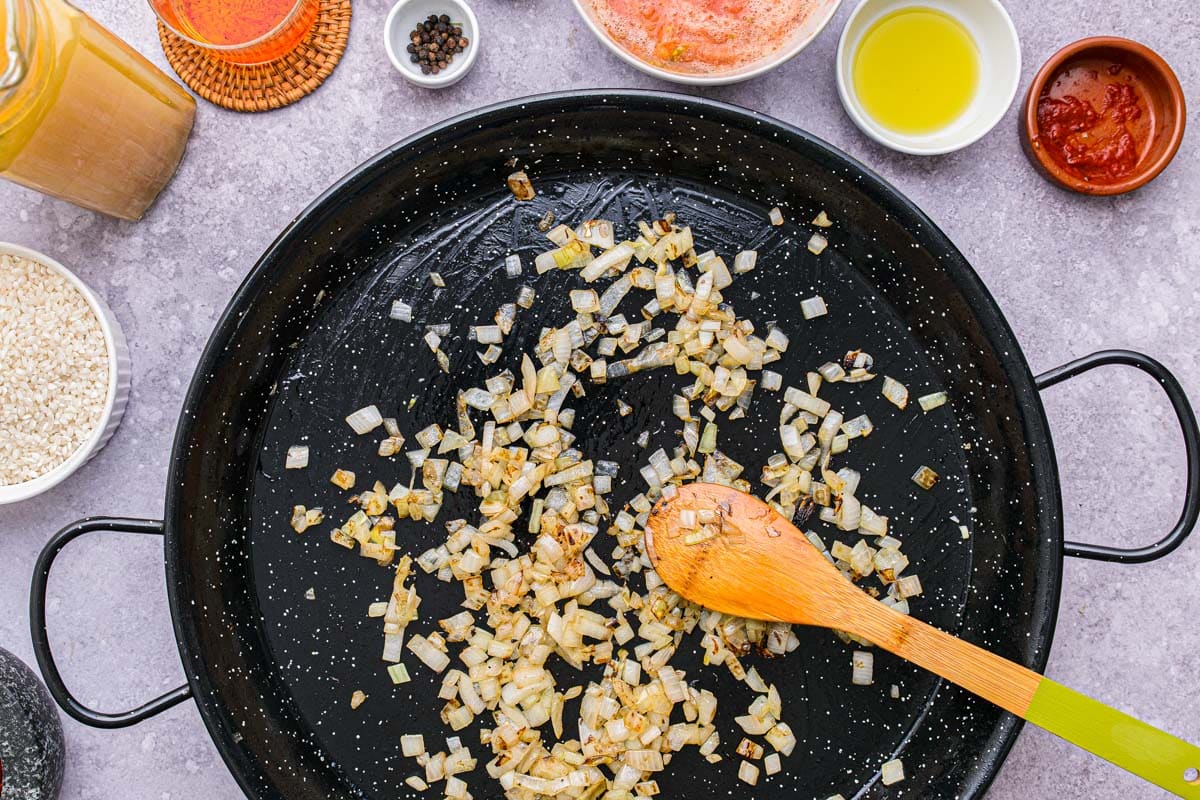
Add the chopped onion to the pan and fry until golden and fragrant. Stir regularly.
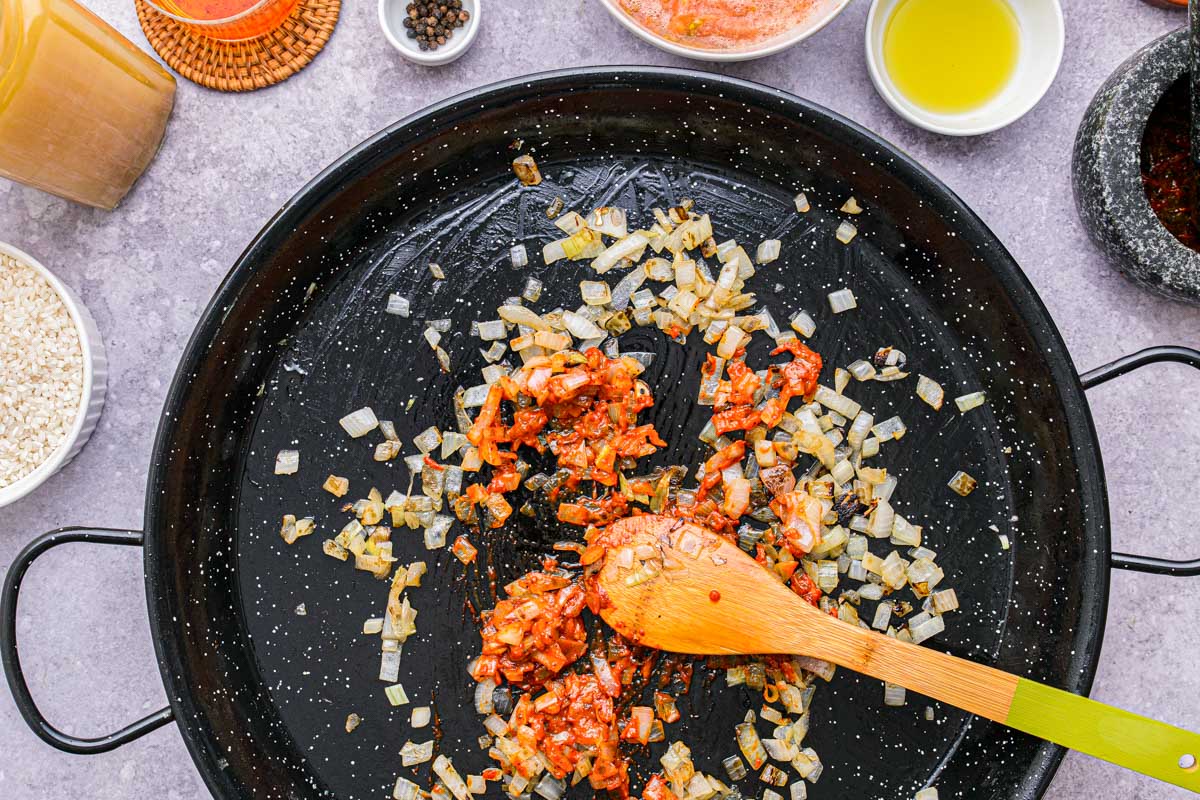
Then add the mortar and pestle mixture and fry for a couple of minutes.
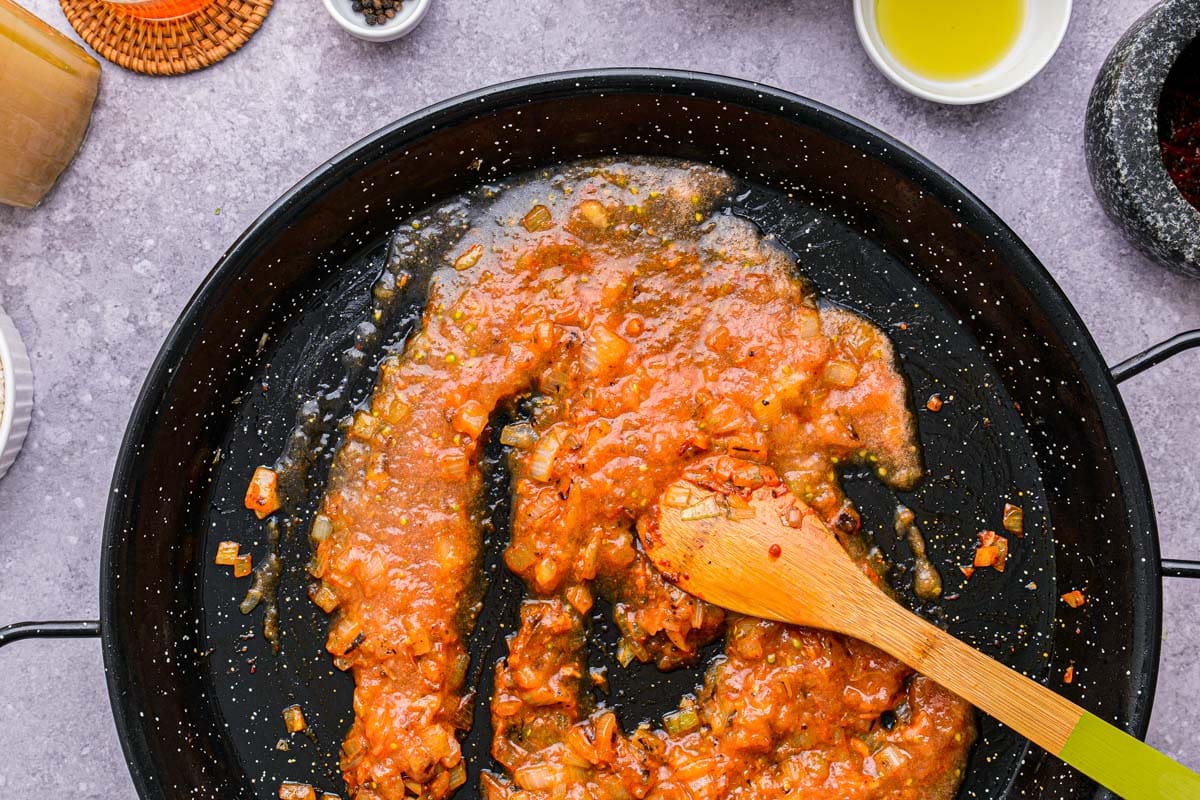
Next, add the grated tomatoes to the pan and fry again for 5 minutes, stirring occasionally.
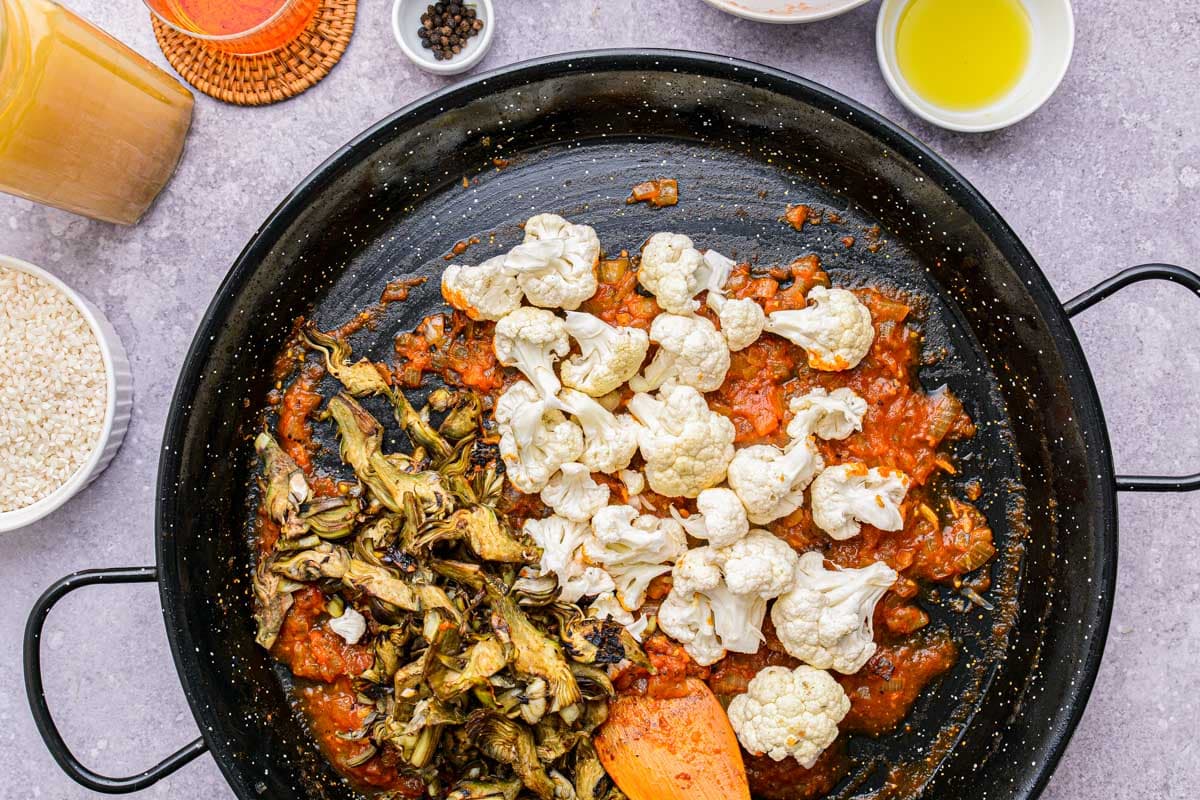
Now add the fried artichokes to the pan along with the cauliflower florets.
Mix well with everything else. Do not add the rest of the vegetables now; you will add them later.
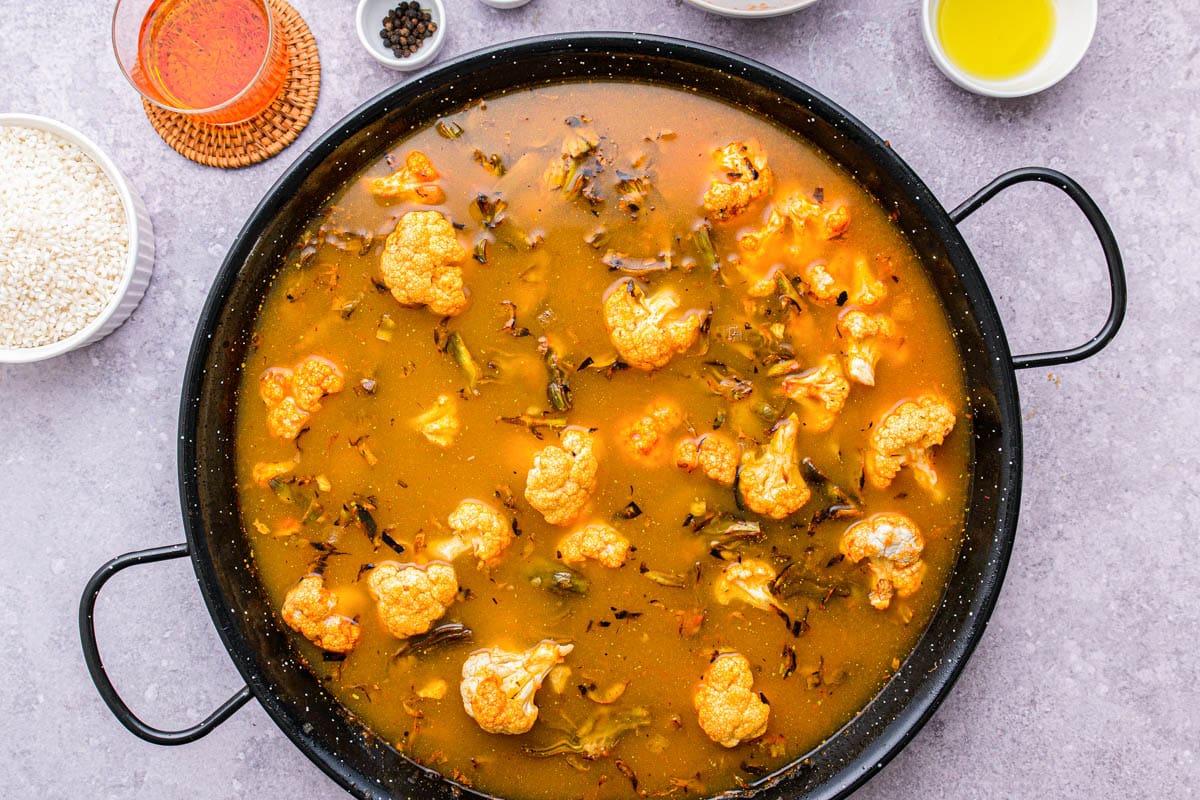
Add the vegetable broth and the saffron infusion to the pan and bring it to a boil.
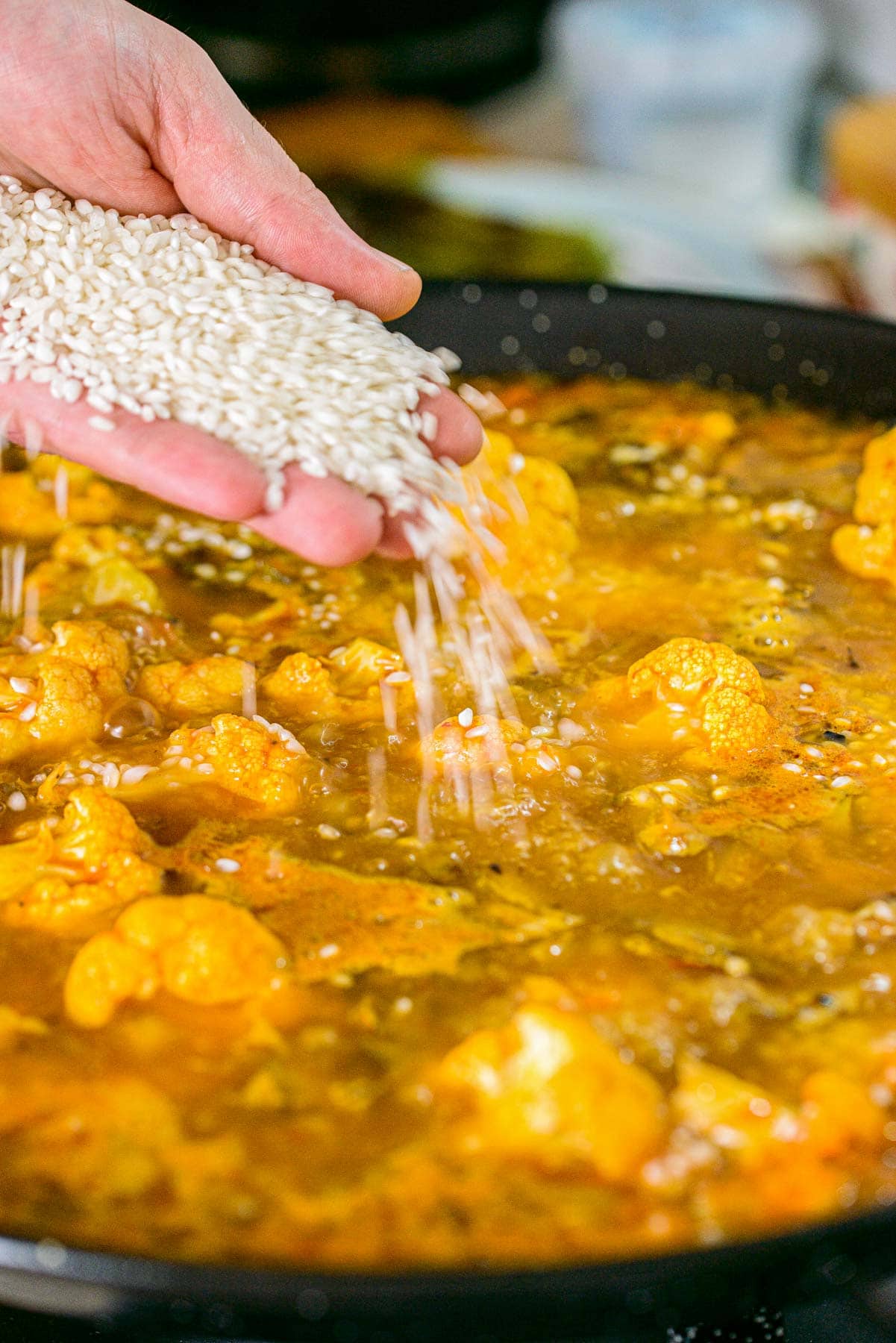
Once the broth is boiling, add the rice evenly to the pan. If needed, use a spatula to help you distribute the rice. Don’t stir the rice around once it’s evenly distributed.
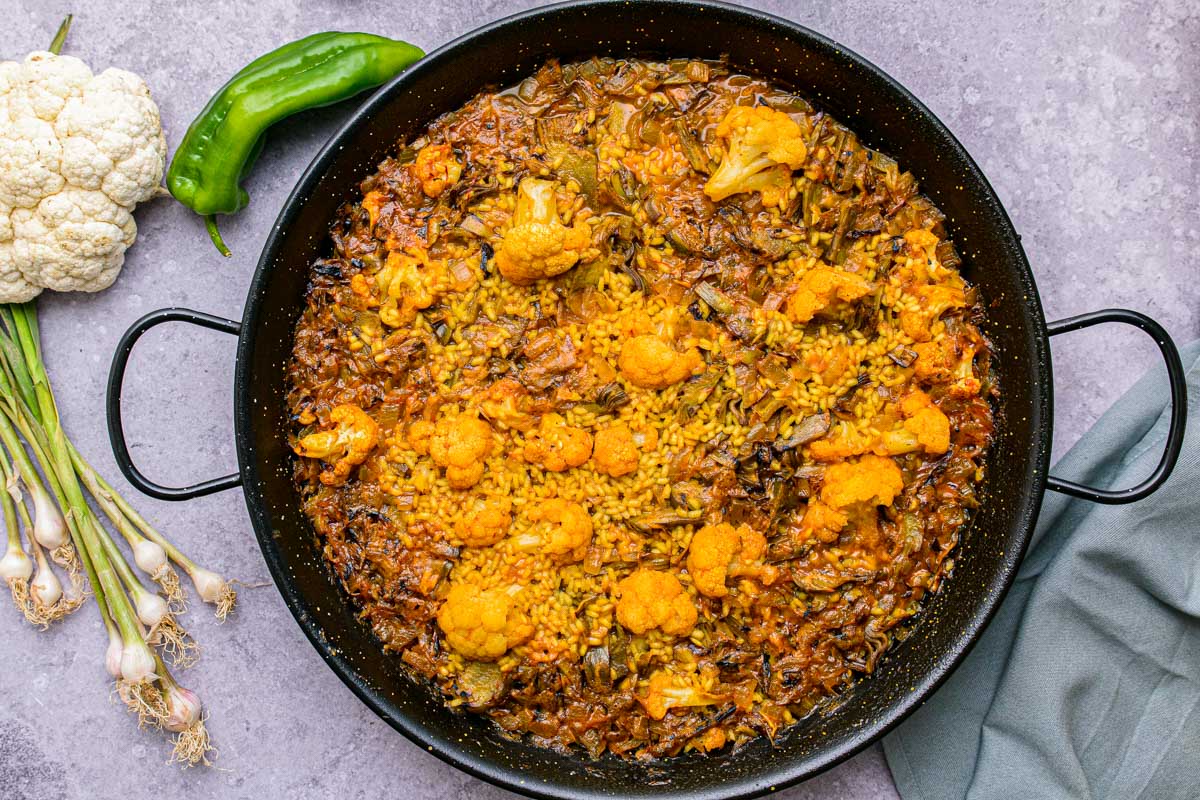
Cook over high heat for 15 minutes, until most of the liquid has been absorbed by the rice. Then lower the heat.
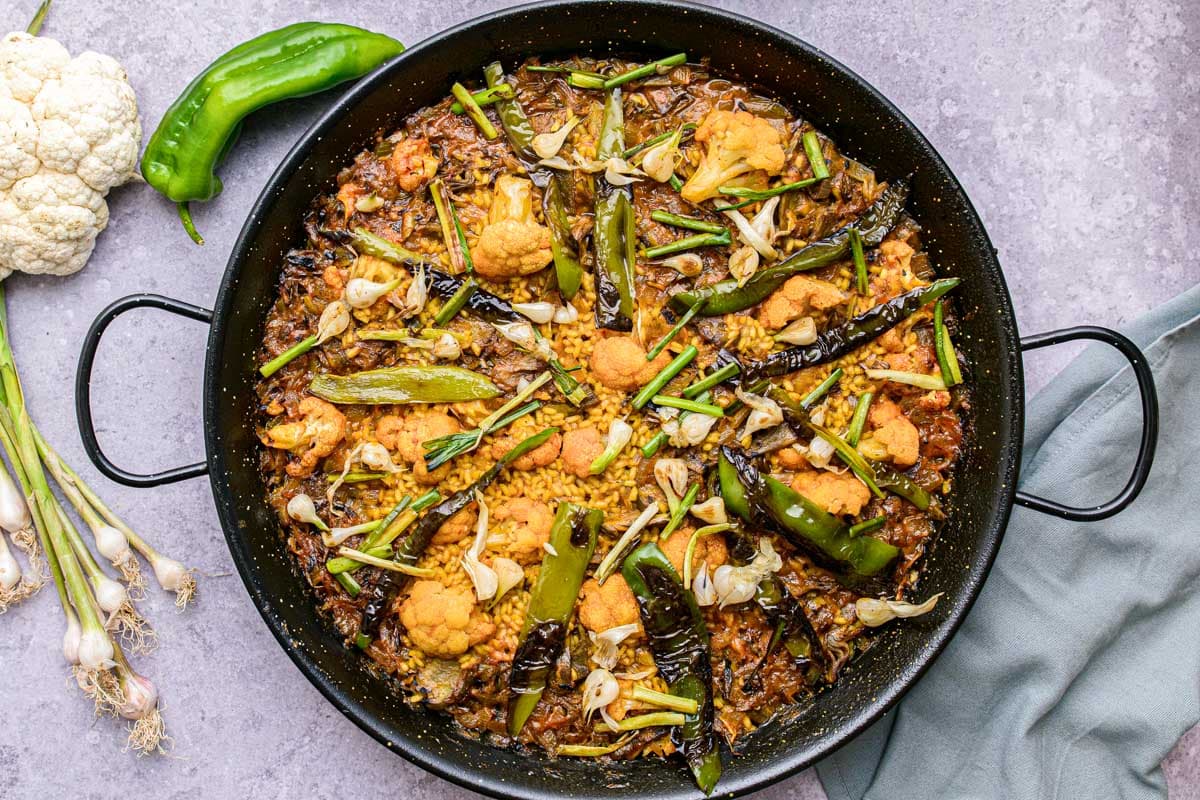
At this point, add the fried green pepper and fried spring garlic, arranging them around the pan.
When there is no more liquid left, turn off the heat, cover with a lid, and let it rest for 5-10 minutes before serving (optional) – see recipe tips above for more “al dente” rice.
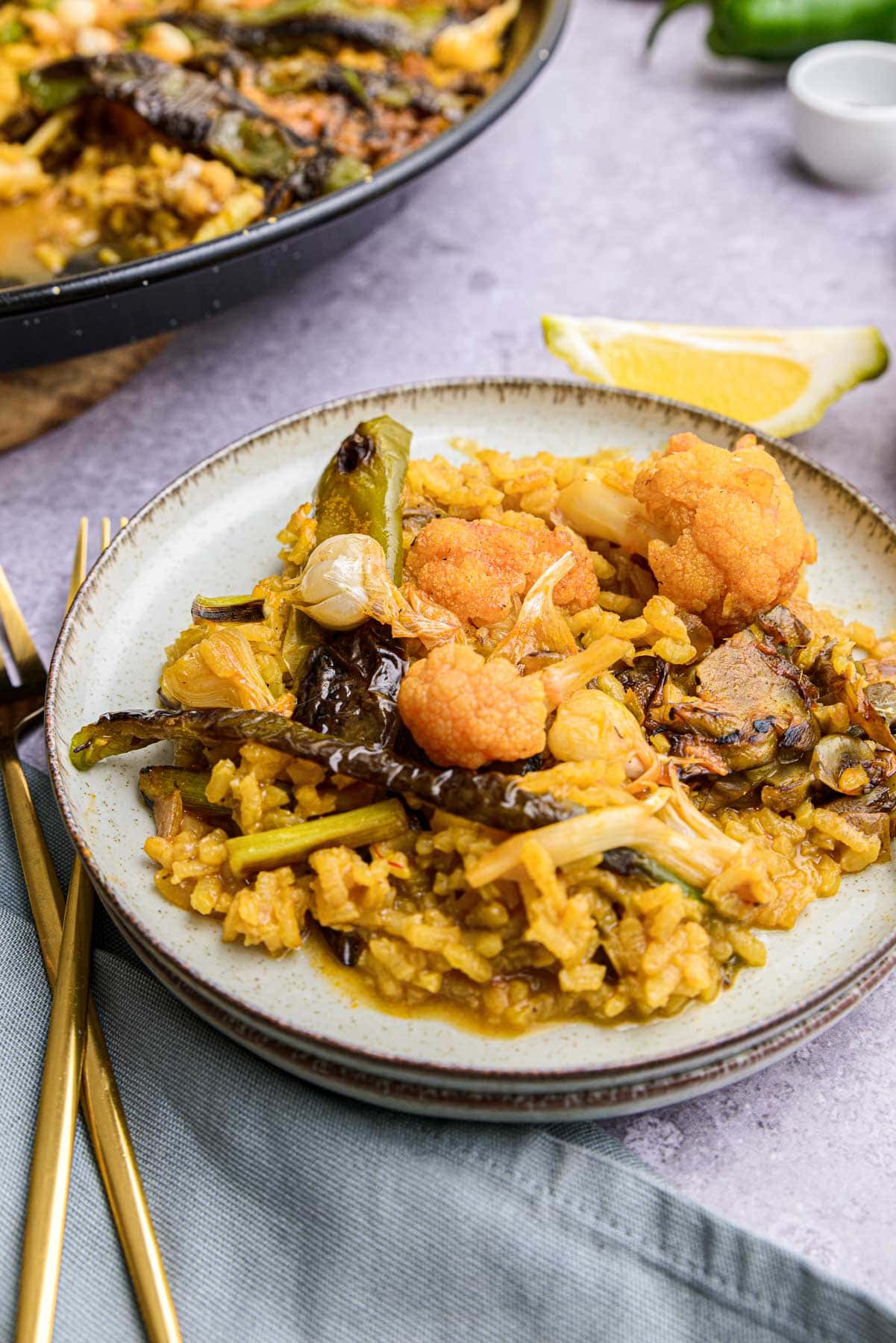
Serve the vegetable paella with sliced lemon and allioli (optional).
Storage Tips
Paella de verduras should be eaten right after being made. However, if you do have leftovers, let them cool and then store them in sealed containers in the fridge for up to 3 days.
FAQ
Here are some answers to questions about vegetarian paella:
Many different vegetables can be used in vegetable paella. More traditional ones include artichokes, green Italian peppers, cauliflower, green peas, flat green beans, red peppers, and asparagus. You can also use eggplant, zucchini or carrots. Don’t use leafy greens like spinach or Swiss chard.
The dish can be optionally served with lemon and allioli (Spanish aioli) as well as a drink of your choice, such as beer, a glass of white wine or water. Do not serve coffee with vegetable paella.
Related Recipes
If you liked this recipe for vegetarian paella, here are some other classic Spanish recipes that you might like as well!
- Authentic Paella Valenciana
- Tortilla de Patatas (Spanish Omelette)
- Empanada Gallega
- Fried Calamari (Calamares a la Romana)
- Romesco Sauce
- Albóndigas en Salsa (Spanish Meatballs)
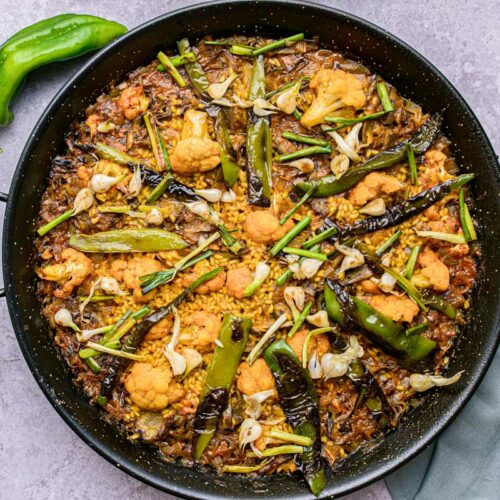
Vegetable Paella
Ingredients
- 5 artichokes
- 1-2 Green Italian Peppers, also known as Cubanelle Peppers; alternatively small green bell pepper
- 1 white onion
- 1 handful spring garlic
- 1/2 head cauliflower, medium-large
- 1 garlic clove
- 3 large tomatoes
- 3 tablespoons olive oil, approximately
- 1 bunch saffron threads, or 1/2 teaspoon saffron powder
- 1/3 cup water, hot
- 2 tablespoons sweet paprika powder, or pimiento choricero meat
- 1 teaspoon salt, more or less to taste
- 1/2 teaspoon black pepper
- 4 cups vegetable broth, preferably homemade
- 2 cups short-grain white rice, see notes
- 1 lemon, for serving (optional)
- allioli, for serving (optional)
Instructions
Prepare The Vegetables
- Wash and dry the vegetables as needed (peppers, cauliflower, tomatoes).
- Artichokes: Cut off the stems, remove the outer leaves, and cut them in half. Remove the inner hairs and cut the artichokes in thin slices.5 artichokes
- Green peppers: Cut off the top and remove the seeds. Slice it into long strips.1-2 Green Italian Peppers
- Onion: Peel and dice finely.1 white onion
- Spring garlic: Cut off the roots and peel off the outer layer. Cut it into chunks.1 handful spring garlic
- Cauliflower: Cut off the stem and break it into small florets.1/2 head cauliflower
- Garlic clove: Peel it.1 garlic clove
- Tomatoes: Cut them in half and grate the pulp.3 large tomatoes
Cook The Vegetables
- In a paella pan, heat up the olive oil and fry some of the vegetables one by one. First, add the artichokes to the pan and fry for a couple of minutes, then remove and set aside.3 tablespoons olive oil
- Add the green pepper and cook for 5 minutes. Remove and set aside.
- Add the spring garlic, fry for a couple of minutes and remove.
Soak The Saffron
- Add the saffron threads to a small bowl and pour the hot water over them. Let them infuse while you continue cooking.1 bunch saffron threads, 1/3 cup water
Prepare The Sofrito / Flavor Base
- In a mortar and pestle, add the garlic clove, ½ teaspoon of salt, a dash of olive oil, and crush until you get a fine paste. Add the choricero pepper meat or paprika powder, salt, and pepper, and mix well.2 tablespoons sweet paprika powder, 1/2 teaspoon black pepper, 1 teaspoon salt
- Add the chopped onion to the paella pan and cook until golden and fragrant. Then add the mortar and pestle mixture and fry for a couple of minutes.
- Add the grated tomatoes to the pan and cook for another 5 minutes, stirring occasionally.
Cook The Vegetable Paella
- Add the fried artichokes to the pan along with the cauliflower florets. Mix well with everything else. Do not add the rest of the vegetables now; you will add them later.
- Add the vegetable broth and the saffron infusion to the pan and bring to a boil.4 cups vegetable broth
- Once the broth is boiling, add the rice evenly to the pan. If needed, use a spatula to help you distribute the rice.2 cups short-grain white rice
- Cook over high heat for 15 minutes, until most of the liquid has been absorbed by the rice. Then lower the heat.
- At this point, add the fried green pepper and fried spring garlic, arranging them around the pan.
- Once there is no more liquid left, turn off the heat, cover with a lid, and let it rest for 5-10 minutes before serving. Serve with sliced lemon and allioli (optional).1 lemon, allioli
Notes
- Use short-grain rice such as Bomba, Sendra, or Calasparra. Avoid long-grain, whole-grain, sushi, or parboiled rice.
- You can use other vegetables such as green peas, flat green beans, red peppers, and asparagus. Eggplant, zucchini and carrots also work. Avoid leafy vegetables.
- Fry the vegetables separately in batches and add them to the pan at different stages, depending on their cooking time.
- If you’re using dried choricero or ñora peppers, hydrate them with hot water while you are frying the veggies. Then scrape their meat with a knife and add it to the sofrito mixture in the mortar.
- Use a large stove and a wide paella pan to cook the paella evenly.
- Do not stir the rice after distributing it in the pan.
- Adjust the amount of liquid and the resting time of the paella according to your preference. If you want a drier and al dente rice, use the amount of broth mentioned above and do not cover the pan with a lid. If you want creamier rice, add more liquid (about 1/3 cup) and cover the pan with a lid for a few minutes after turning off the heat.
Nutrition
This nutritional information has been estimated by an online nutrition calculator. It should only be seen as a rough calculation and not a replacement for professional dietary advice.
